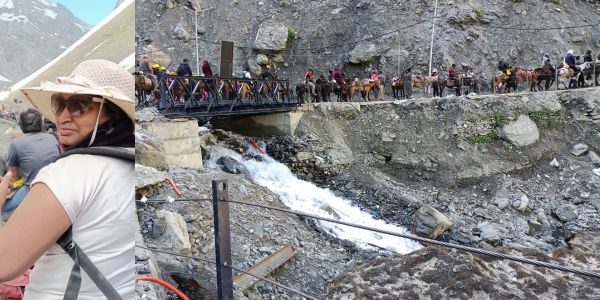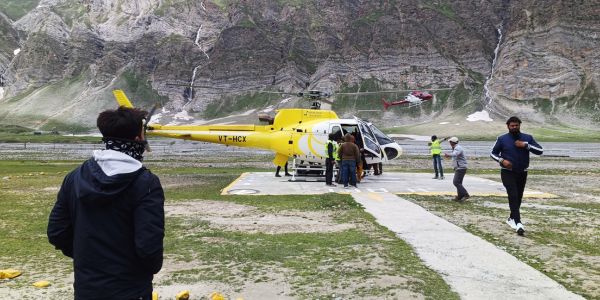Plan your Amarnath Yatra 2025! Get insights on registration, routes (Pahalgam, Baltal), trekking tips, and the spiritual significance of this Himalayan pilgrimage to Baba Amarnath.
The revered Amarnath Yatra, a significant pilgrimage for Hindus, beckons devotees to the sacred Amarnath Cave nestled high in the Himalayas of Jammu and Kashmir. This annual journey is undertaken by lakhs of pilgrims seeking the darshan of the naturally formed ice Shiva Lingam. The Shri Amarnathji Shrine Board (SASB) has announced the schedule for the Amarnath Yatra 2025, inviting pilgrims to embark on this spiritual quest.
The Yatra is scheduled to commence on July 3, 2025, and will conclude on August 9, 2025, spanning 38 days.
The Spiritual Significance
The Amarnath Cave holds immense religious importance. It is believed to be the sacred place where Lord Shiva imparted the secrets of immortality and the creation of the universe to Goddess Parvati. The cave houses an ice stalagmite, revered as the Shiva Lingam, which waxes and wanes with the phases of the moon, reaching its peak during the Shravan Purnima (Raksha Bandhan) – the traditional culmination day of the Yatra. The pilgrimage is considered one of the holiest in Hinduism, a journey of faith, penance, and divine blessings.

Amarnath Yatra 2025: Key Details
- Dates: July 3, 2025, to August 9, 2025
- Duration of Yatra: 38 days
- Registration:
- Start Date: April 14, 2025
- Modes:
- Online: Through the official Shri Amarnathji Shrine Board (SASB) website: https://jksasb.nic.in
- Offline: Via designated branches of Punjab National Bank (PNB), State Bank of India (SBI), Jammu & Kashmir Bank, and Yes Bank across India.
- Registration Fee: Approximately ₹220 per yatri.
- Group Registration: Guidelines for group registration are also available on the SASB website.
- Daily Pilgrim Limit: Approximately 15,000 pilgrims per day (combined for both routes).
The Sacred Journey: Routes to the Holy Cave
Pilgrims can undertake the Amarnath Yatra through two primary routes:
- Pahalgam Route (Traditional Route):
- Distance: Approximately 46 kilometers one way.
- Duration: Takes about 3-5 days to complete.
- Characteristics: This is the longer and more traditional route, known for its scenic beauty and gradual ascent, making it relatively less strenuous for many pilgrims, especially the elderly.
- Key Stops: Chandanwari, Pissu Top, Sheshnag, and Panchtarni.
- Baltal Route:
- Distance: Approximately 14 kilometers one way.
- Duration: Can be completed in 1-2 days.
- Characteristics: This is a shorter but significantly steeper and more challenging route, preferred by younger and physically fit pilgrims.
- Key Stops: Domail, Barari Marg, and Sangam (where both routes converge before leading to the Holy Cave).
Helicopter Services: For pilgrims who may find the trek arduous, helicopter services are available from Baltal (Neelgrath) and Pahalgam to Panchtarni. From Panchtarni, the Holy Cave is a few kilometers trek or can be covered by pony/palanquin.

Essential Prerequisites for Pilgrims
To ensure a safe and regulated Yatra, the SASB has mandated the following:
- Yatra Permit (YP): A valid Yatra Permit, obtained after successful registration, is mandatory.
- Compulsory Health Certificate (CHC): Every pilgrim must possess a CHC issued by an authorized doctor or medical institution, certifying their fitness for the high-altitude trek. The list of authorized institutions is available on the SASB website.
- RFID Card (Radio Frequency Identification): An RFID card is compulsory for every yatri for tracking and security purposes. These cards are issued after biometric eKYC verification at designated centers in Jammu and Kashmir before commencing the Yatra.
- Age Limit: Pilgrims must be between 13 and 70 years of age.
- Health Restrictions:
- Pregnant women with more than 6 weeks of pregnancy are not permitted to undertake the Yatra.
- Individuals with serious cardiac, respiratory, or other chronic health conditions are advised against the pilgrimage due to the challenging terrain and high altitude.
Preparing for the Pilgrimage
The Amarnath Yatra is a demanding journey requiring adequate physical and mental preparation:
- Physical Fitness:
- Start preparing at least a month in advance.
- Engage in regular walks (4-5 km daily), jogging, or other cardiovascular exercises.
- Practice deep breathing exercises and yoga, especially Pranayama, to improve oxygen efficiency at high altitudes.
- Medical Check-up: Consult your doctor and get a thorough medical examination before planning the Yatra.
- Acclimatization: It is crucial to acclimatize to the high altitude. Arrive at the base camp (Baltal or Pahalgam) at least 1-2 days before starting the trek.
- Packing Essentials:
- Clothing: Pack warm clothing in layers (thermal wear, sweaters, fleece jackets, windproof and waterproof outer jacket and trousers).
- Footwear: Sturdy, waterproof trekking shoes with good grip are essential. Carry extra pairs of woolen socks.
- Headgear: Woolen cap or balaclava to protect against the cold.
- Gloves: Waterproof and warm gloves.
- Rain Gear: A good quality raincoat or poncho, as weather in the mountains can be unpredictable.
- Other Items: Walking stick for support, torch with extra batteries, sunglasses, sunscreen lotion, lip balm, moisturizer.
- First-Aid Kit: Include essential medicines for headache, fever, pain relief, common cold, diamox (for altitude sickness, after consulting a doctor), bandages, antiseptic, etc.
- Hydration: Carry a reusable water bottle to stay hydrated.
- Snacks: Energy bars, dry fruits (almonds, walnuts, raisins), roasted chana, jaggery, and chocolates for instant energy.

Facilities and Services for Yatris
The SASB and local authorities provide various facilities for the pilgrims:
- Accommodation: Tented accommodations and pre-fabricated huts are available at designated campsites along both routes, provided by government agencies and private operators. These usually offer mattresses, pillows, and blankets.
- Food (Langars): Numerous langars (community kitchens) are set up by religious and social organizations, offering free food (sattvik vegetarian meals), water, and refreshments to the pilgrims along the Yatra routes. Government-run depots also provide rations at reasonable prices.
- Medical Facilities: Medical camps, first-aid posts with doctors, paramedics, and nursing staff are established at regular intervals. Emergency oxygen cylinders, basic medications, and IV fluids are available. Mobile health units and ambulances are also deployed. Helicopter services are available for emergency medical evacuations from Panjtarni and other critical points.
- Communication: While personal prepaid mobile connections from other states may not work in Jammu & Kashmir, BSNL often provides special pre-loaded Yatra SIM cards for pilgrims.
- Transportation:
- Ponies and Palanquins (Dolis): Available for hire for those who find it difficult to trek. Rates are usually fixed by the authorities.
- Helicopter Services: As mentioned, these operate to Panjtarni. Bookings should be done in advance through authorized operators.
- Insurance: Registered pilgrims with valid Yatra Permits are often covered by an accidental insurance policy provided by the SASB.
Important Guidelines and Advisories (Do’s and Don’ts)
Do’s:
- Carry your Yatra Permit, RFID card, and a valid photo ID at all times.
- Undergo a thorough medical check-up before the Yatra.
- Acclimatize properly to the high altitude.
- Drink plenty of water (at least 5 liters a day) to stay hydrated and prevent altitude sickness.
- Eat light, nutritious, and easily digestible food.
- Travel in a group and ensure all members are within sight.
- Follow the instructions issued by the Yatra Administration and security personnel.
- Wear appropriate layered clothing and sturdy trekking shoes.
- Use the designated toilet facilities.
- Dispose of waste in the dustbins provided to keep the environment clean.
- If you experience symptoms of altitude sickness (headache, nausea, dizziness, breathlessness), immediately descend to a lower altitude and seek medical attention.
Don’ts:
- Do not undertake the Yatra if you are not medically fit or fall outside the permissible age group.
- Do not start the trek without a valid Yatra Permit and RFID card.
- Avoid consuming alcohol, caffeinated drinks, smoking, or any form of intoxicants.
- Do not stop at places marked with warning notices or in landslide-prone areas.
- Do not attempt any shortcuts on the route, as they can be dangerous.
- Do not wear slippers or sandals; only wear trekking shoes.
- Avoid wearing sarees; salwar kameez, pants, or tracksuits are more suitable for ladies.
- Do not litter the Yatra area. The use of plastics is strictly prohibited.
- Do not engage in any activity that could cause pollution or harm the environment.
- Do not overexert yourself. Walk at a comfortable pace.
Banned Food Items: Non-vegetarian food, carbonated soft drinks, canned and processed foods, fried snacks (like chips, pakoras), pickles, chutneys, gutka, pan masala, and tobacco products are generally banned in the Yatra area to maintain the sanctity and health of the pilgrims.
How to Register (Step-by-Step Guide – General Process)
Online Registration:
- Visit the official SASB website: https://jksasb.nic.in.
- Navigate to the “Online Services” section and click on “Yatra Permit Registration.”
- Read all the guidelines carefully and agree to the terms.
- Fill in the online application form with accurate personal details, preferred Yatra date and route, Aadhaar number, and mobile number.
- Upload a recent passport-size photograph and a scanned copy of your Compulsory Health Certificate (CHC).
- Verify your mobile number using the OTP sent to your registered number.
- A payment link will usually be sent within a few hours to pay the registration fee (approx. ₹220).
- After successful payment and verification, you can download your Yatra Permit.
Offline Registration:
- Visit one of the designated bank branches (PNB, SBI, J&K Bank, Yes Bank).
- Obtain the Yatra application form.
- Fill in the form and submit it along with the required documents:
- Compulsory Health Certificate (CHC).
- Four passport-size photographs.
- Proof of identity (Aadhaar card or other valid government ID).
- Pay the registration fee.
- The bank will issue the Yatra Permit for the specified date and route, subject to availability.
Must Read: Top 50 Global Universities in 2025: Leading the Way in Higher Education
Conclusion
The Amarnath Yatra is more than just a pilgrimage; it is an experience that tests one’s endurance, faith, and devotion. By preparing adequately, adhering to the guidelines, and respecting the sanctity of the holy place and its environment, pilgrims can ensure a safe, smooth, and spiritually fulfilling journey.
For the most current and detailed information, always refer to the official website of the Shri Amarnathji Shrine Board (https://jksasb.nic.in).
Jai Baba Barfani!

